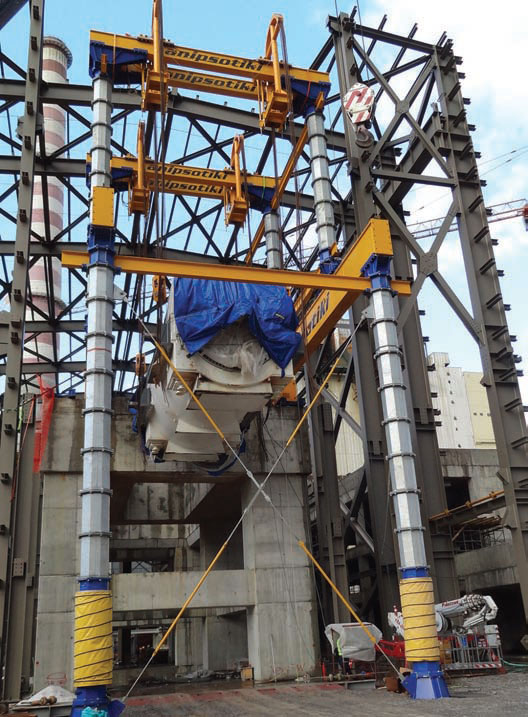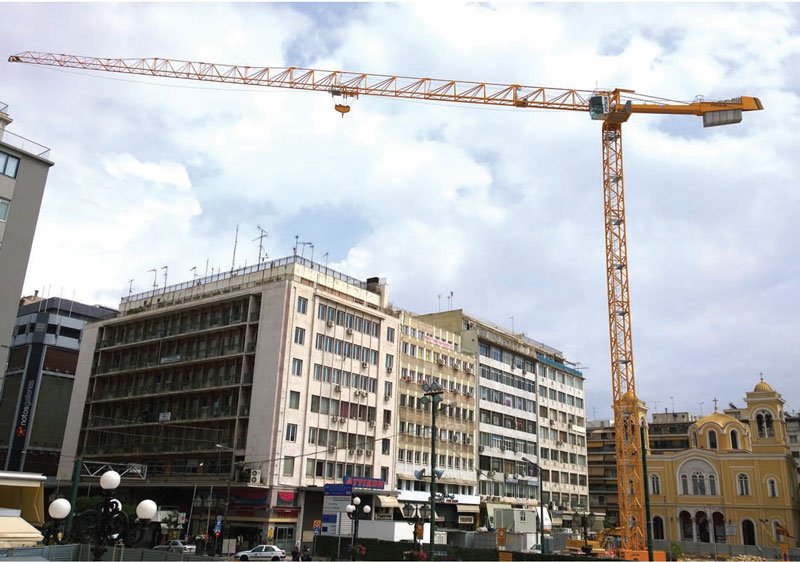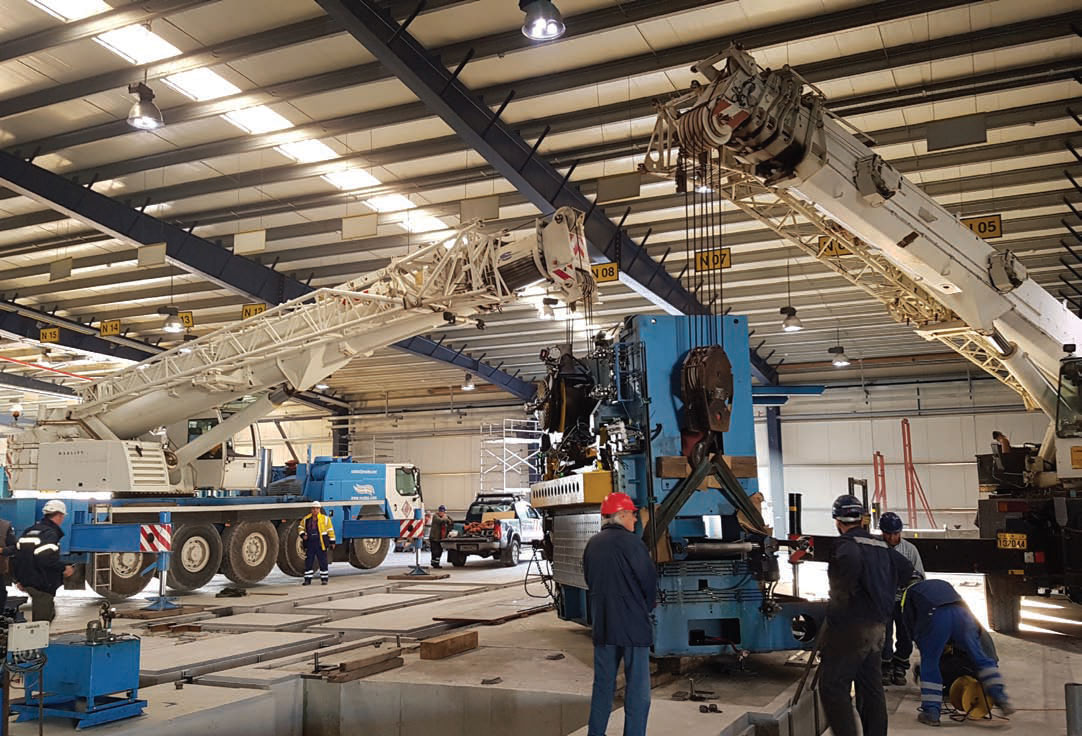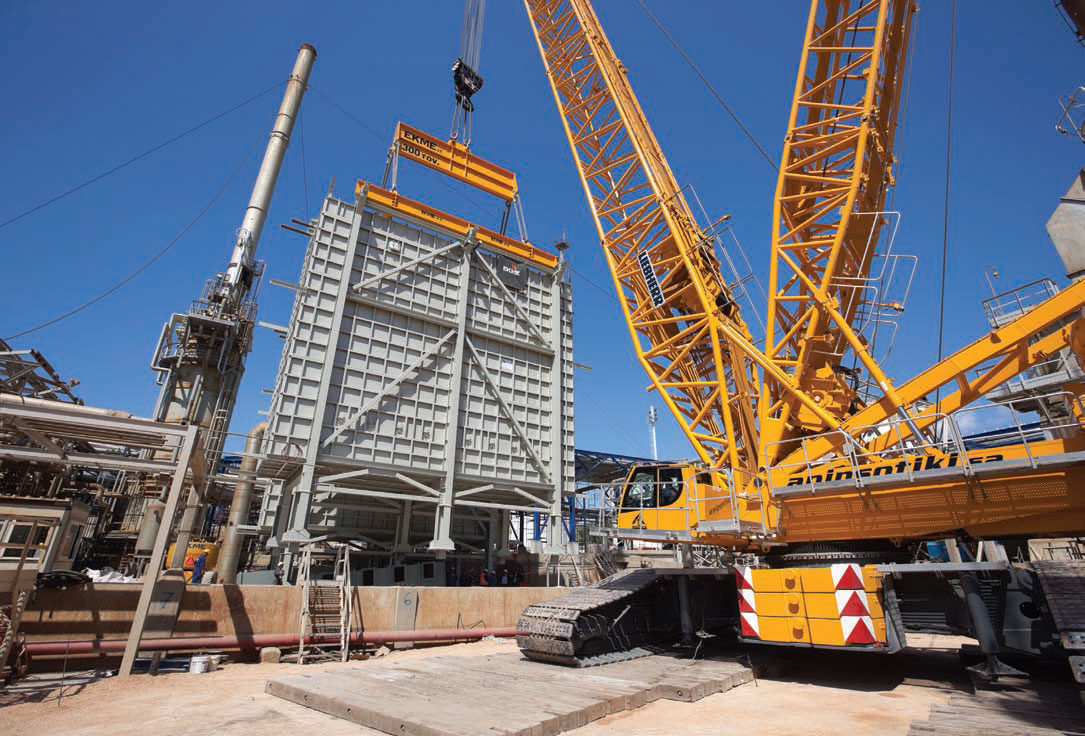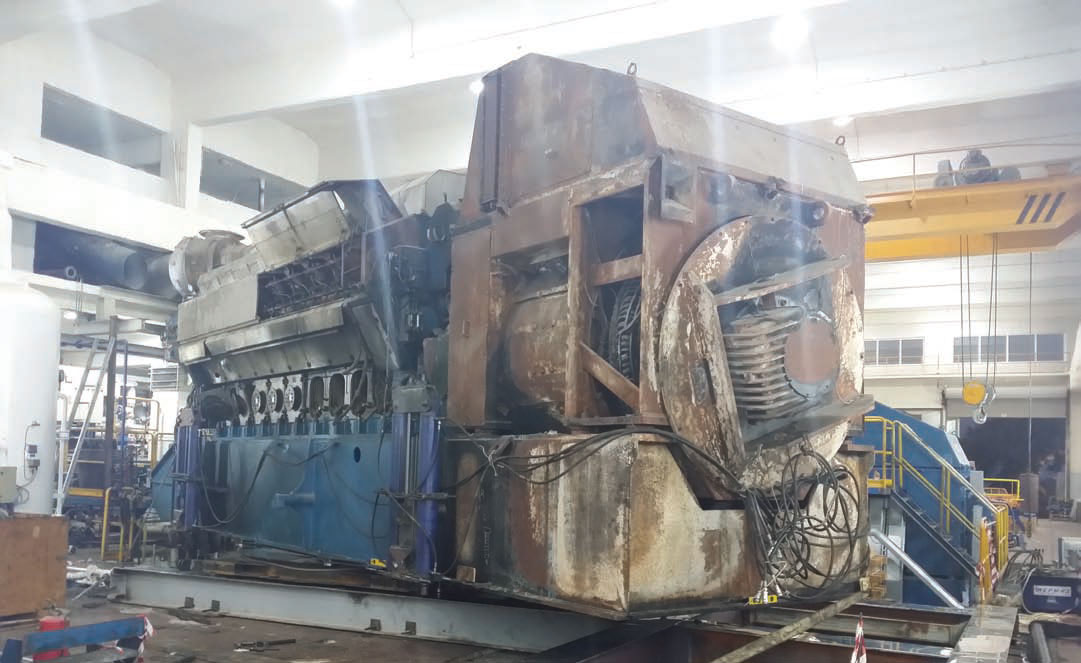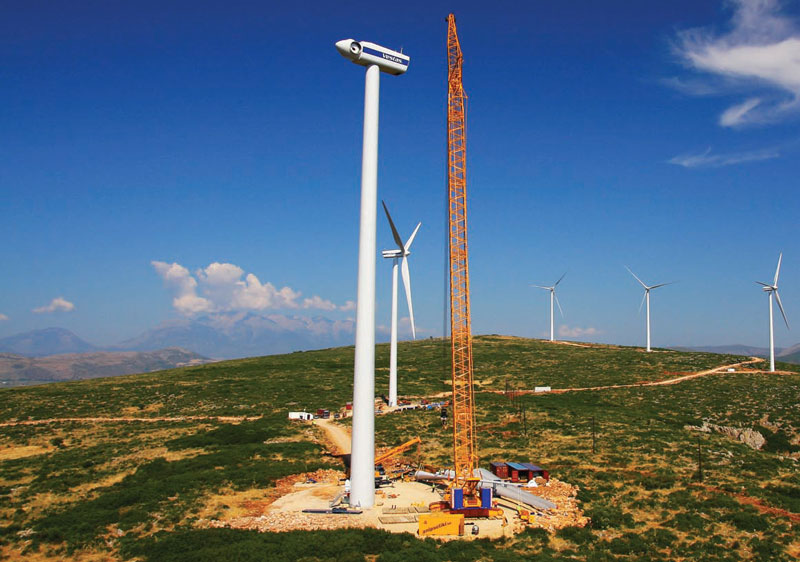Hitting back
22 January 2018Greece has being severely hit by the financial crisis, but crane dealers and rental companies have not turned the other cheek, they found ways to maintain a healthy business. Sotiris Kanaris reports.
It has been ten years since the implosion of Lehman Brothers, which triggered a financial crisis around the world. Europe was hit in 2009, and its effect was mostly felt in a number of highly indebted Southern European countries, including Greece, which has been dependent on international bailouts. The country’s GDP has fallen from $354.5bn in 2008 to $194.6bn in 2016. This adverse economic environment could not have left the crane industry unaffected, with crane sales ‘historically low’.
“The crane market has been severely hit by the economic crisis and the sales figures are at a historic low. Demand for new cranes has been extremely low and the market has been working historically with used cranes,” says Alexander Adamakos, managing director at Adamakos Equipment Services—local dealer for Potain tower cranes, Grove mobile cranes, PM knuckle boom hydraulic cranes and Scanreco radio remote controls.
The main reasons behind the low crane sales have been the limited access to finance for crane rental companies, as banks have been reluctant to lend, and heavier taxation.
Anipsotiki has recently placed an order for a 750t telescopic all terrain crane. “We mainly use our own money to buy new equipment,” says Yiannis Koukis, general manager of the crane rental company. Koukis says the financial crisis acted as an opportunity for some big rental companies to sell some old cranes abroad and replace them with more recent secondhand models, resulting in smaller but younger fleets.
Anipsotiki decided to purchase the 750t crane to replace a 500t crawler crane. The reason behind the purchase was the flexibility of all terrains as well as the ability to perform heavier lifts due to its higher capacity.
“We have 400t, 600t, 650t and 750t capacity crawler cranes, but these cranes are not so easy to move to unload something from a vessel or service wind turbines. The telescopic crane gives you more flexibility and lower cost,” says Koukis.
The company’s crane fleet consists of: two Liebherr crawlers; four Liebherr and two Demag all terrains; and Fassi, Copma and Effer truck mounted cranes.
The market for buying cranes may be performing badly but crane rental activity is strong. “This year, the demand is increasing so it is not easy to find a crane especially in the range of 90-300t,” says Koukis.
John Voutas of Voutas S.A. found there has been an increase in demand for small mobile cranes between 50t-100t for everyday lifting in the cities. The company, established in 1882, has Liebherr and Demag all terrain cranes in its fleet, as well as trailers for special transport.
Recently Voutas S.A. was appointed to transport and install a 43t furnace for Teka Systems. The furnace was bought from Halcor Metal Works, which had previously used it for metal annealing.
At Halcor Metal Works’s facility, Voutas parked its 95t Liebherr LTM1095-5.1 and 50t LTM1050-4 mobile cranes. In a tandem lift, the two cranes lifted the furnace and placed it on Goldhofer modular trailers, which were used to transport the furnace to Teka Systems. At the final site, using the same method as before, the two cranes lifted and installed the furnace.
Yiannis Foussekis, managing director at Hermes Group, says 90t and 160t cranes have been the most popular, but in the past two years there has been high demand for 500t cranes, mostly to work on highway construction. Hermes’ fleet consists of mobile and lattice boom cranes up to 600t from Liebherr, Demag and Grove. It also has articulated cranes up to 120t/m from Fassi, PM and HMF.
Voutas has also seen an increase in demand for higher capacity cranes in the energy sector, for wind turbine erection and jobs at refineries.
The construction of a new unit at the Ptolemaida power plant, which is one of the biggest infrastructure projects in Greece at the moment, demands a large number of cranes. Hermes Group is supplying cranes up to 500t and articulated cranes. For this project Sarens has dispatched equipment from across the globe, including a Terex Demag CC8800-1 SWSL, a CC2400-1 S and two Liebherr LR1750 SDBW.
The wind energy sector has been driving a lot of business for crane rental companies, with Koukis saying that at Anipsotiki around 90% of the heavy lifts done by its crawlers are wind turbine erections. Koukis expects the demand for wind turbine installations to remain high until the end of 2018, and then decrease as the feed-in tariff system will be replaced by an auction system.
The development of the metro system in Thessaloniki and the expansion of the Metro Line 3 in Athens, have also created demand for cranes. Hermes has provided its Demag AC500-2 to lift a tunnel boring machine in Thessaloniki, while Adamakos has supplied tower cranes for the Athenian project.
In 2012, the owner and operator of the Athens Metro, Attiko Metro S.A., signed a contract with the contracting joint venture J&P Avax, Ghella and Alstrom Transport for the Metro Line 3 extension to Piraeus port. This extension will be 7.6km long and will add six new stations to the metro network, serving both the western suburbs of the Athens basin and the areas of Piraeus, which will have three modern metro stations.
Adamakos Equipment Services has sold five new Potain tower cranes to this joint venture, four MDT 218A and an MD 310C K12. To this date, it has also rented 15 tower cranes for this project – including Potain models HD26A, MC85B and MD 208.
The tower cranes have been used for earth-moving jobs using skips and for lowering into the tunnel the cement segments for the tunnel walls. At the final stages they will be used for laying the train tracks and install the required electromechanical equipment.
Adamakos Equipment Services’ tower crane rental fleet consists of hydraulically self-erecting cranes and topless and saddle-jib tower cranes. Adamakos says the most popular models for hire have been the Potain MD185B and MC85B.
Another example of a civil infrastructure project has been the erection of Tsakona bridge, on the highway between Tripoli and Kalamata. The arch bridge has a 175m span and Anipsotiki had to lift the segments of the arch and temporary supports.
“The bridge started from 12m and went up to 60m high; we had to install strand jacks on top of the temporary structure and lift the segments which weighed from 280t to 340t,” said Koukis.
Anipsotiki’s fleet of alternative lift systems consists of strand jacks, gantries, and strand jack gantries. This last is a special system that allows for lifting inside the building.
It can lift power house loads up to 500t and install them on the pedestals on the foundations which can be between 3m and 12m high. The equipment the company uses is mainly from Enerpac.
The limited space in power generators in the Greek islands and the need for replacement of old engines also demand alternative lifting systems. Hermes Group had to develop its own skidding system in order to overcome obstacles like skidding the generators over big gaps inside the facilities, or rotating generators between others in operation.
International lifts
During rough times in the domestic market, Greek rental companies have won various contracts around the world.
Their expertise in wind energy lifting applications has been appreciated outside the borders. Hermes Group has been involved in various projects in Balkan countries and has recently supplied a 600t crawler crane for the replacement of three FL 2.5MW rotors in Kazanlak, Bulgaria. Anipsotiki has been involved in the erection of 365 small wind turbines in Lake Turkana, Kenya, as well as other wind projects in Pakistan, Jordan, Turkey, the Former Yugoslav Republic of Macedonia (FYROM), and Georgia.
“We are invited in to tenders abroad because we are very specialised in wind mills, due to the fact that Greece is a very difficult country in respect of landscape and transportation, and because we have good and long relationship with most of the manufacturers,” says Koukis.
Koukis says that another reason behind the demand for cranes from neighbouring countries is that in some the market is so small that local rental companies do not have high capacity crawlers.
Apart from wind turbine erection, Anipsotiki has been involved in other energy projects outside Greece. For example it has installed boilers using strand jacks in Syria and installed generators and transformers in Algeria.
It rents cranes to sister companies abroad with equipment from their depots in Greece and Cyprus. The company also formed a joint-venture in Jordan through which it has invested in a 600t crawler based there.
With the recent addition of a 600t in its fleet, Hermes Group anticipates an increase in business from abroad in the near future. Adamakos Equipment Services also has an international footprint with many collaborations and ongoing projects in Cyprus, Bulgaria, Albania, FYROM, Poland and Iraq.
Special transport and regulation
The power plant in Ptolemaida has also created demand for specialised transport, as heavy construction components and equipment has to be moved to this remote site. Both Voutas and Hermes Group have supplied trailers for this job. Some of the usual specialised transport jobs in Greece are moving equipment for power plants and oil refineries; beams for bridge construction; cranes and counterweights; and wind turbine components.
For the latter application, Anipsotiki has purchased tower adaptors and a blade lift. “The blade lift is a device assembled on a modular trailer that you can bolt the blade on and lift it up to 60°, so you can move through corners and narrow streets, avoiding modifications on the road. These are from Goldhofer,” Koukis says.
He explains that this is the preferred method for blade transportation from the clients.
“Greece is a mountainous country, so without these machines you might need to do extensive excavation or back filling and this has a big impact on the environment and the cost of excavation is also quite big.”
Anipsotiki’s transport equipment also includes extendable trailers, Goldhofer modular trailers and several prime movers.
Apart from the landscape, regulation also poses challenges to companies involved in special transport. Hermes Group’s Yiannis Foussekis is president of the local special transport trade group.
The local association has been proposing measures for an easier movement of heavy and oversized loads as well as questioning some of the existing regulations for the past decade.
The association says its members are withstanding inexcusable limitations to operate because of “incomplete and unclear regulation” and that some laws make operation difficult. The companies have to get a permit for vehicles even when they are moving without carrying any load.
At the same time, the association says, the authorities are lenient with the transportation of heavy and oversized loads on vehicles which do not meet the standards.
Some of the solutions the association proposed to the government for the improvement of the industry are: The setting of technical requirements for the vehicle configuration, the appropriateness of a vehicle for carrying different types of load, with an emphasis on the weight per axle rather than gross weight; the removal of the ban on night transportations; removal of the 40km/h maximum speed limit, as it does not respond to the manufacturers specifications; the establishment of a long term permit when it comes to routine transportations.
Foussekis, is frustrated with the government’s lack of response to the industry issues. He is a supporter of a Pan-European harmonization of practices and regulation, according to the European Best Practice Guidelines for Abnormal Road Transport.“There is also a need for proper education of drivers in terms of tethering and safe loading,” says Foussekis.
Regulatory issues exist for the crane industry as well, with Koukis saying that the laws are outdated and incomplete. In addition, he says that the privatisation of highways has changed the state permit system to one where companies are given a permission or an acknowledgement that they can drive.
“Even for a 90t crane you have to get permissions every time for your route, which is a little bit time consuming. This needs to be changed as a 90t is not so heavy or big. It is wider than 2.5m, but apart from this, there is no ill interaction in traffic,” adds Koukis.
He says the re-establishment of a local crane rental association would be a better vehicle to push for changes, and there are now efforts in that direction. Koukis says there are discussions with a technical college for the creation of a lifting equipment department, which could have a long-term positive effect on the industry.
The industry seems to be unclear about business activity in the near feature. Adamakos says: “At the moment there is still a great degree of uncertainty in the industry and it is not clear what the situation in the market will be like over the next years. There are important public and private sector projects in the pipeline, however there is great uncertainty as to whether they will go ahead, mostly due to project financing difficulties.”
Foussekis highlights that sometimes it takes years for investments to be licensed by the government, which makes investors rethink about going forward with them.
Adamakos says: “In direct link to the general uncertainty in the economy and the construction industry, the crane market is most likely going to remain focused on used cranes in the near future.”
On the positive side, the expertise of Greek crane rental companies in association with high capacity cranes in their fleet has generated business not only from neighbouring countries but also from Middle East and Africa. This could compensate lower rental demand in Greece, allowing them to remain profitable in these difficult financial times.
